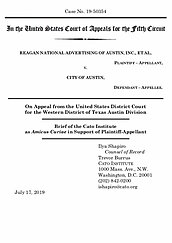Learn more about Cato’s Amicus Briefs Program.
When does a local ordinance relating to commercial signage become an unconstitutional regulation of speech? That is the question before the Fifth Circuit in Reagan National Advertising of Austin v. City of Austin — a case that, if Austin, Texas has its way, could bring a troubling course correction to existing commercial-speech doctrine.
Austin’s sign code distinguishes “on-premise” from “off-premise” signs, prohibiting the construction of new “off-premise” signs — that is, signs that advertise products or businesses located elsewhere — while at the same time allowing for new “on-premise” signs. Austin argues that the distinction is rationally related to the aims of preserving the city’s aesthetic character and ensuring public safety. When advertising company Reagan National applied to construct dozens of off-premise signs, a mainstay of Reagan’s advertising business, the city denied the permit.
Reagan National sued under the First Amendment. The district court applied so-called intermediate scrutiny and upheld the regulation. Now, on appeal to the Fifth Circuit, Reagan National asks the court to overturn the district court and Cato has filed a brief in support.
We argue that the proper standard of review in this case is strict scrutiny — a standard the law certainly fails. The regulation here is content-based, though it might not seem so at first glance. Content-based restrictions are, as the Supreme Court has said, “those that target speech based on its communicative content” and are “presumptively unconstitutional” unless the law passes strict scrutiny. Because Austin allows for the construction of new signs that read, say, “buy here,” while at the same time prohibiting the construction of new signs that read “buy there,” then otherwise identical signs are therefore treated differently based upon the message conveyed — that is, the content. Surely, both types of sign, conceivably identical in every other way save for the physical address to which it directs potential customers, would equally affect the attention of drivers or a city’s existing beauty.
Moreover, even if the court doesn’t apply strict scrutiny, the city’s rationale fails the more forgiving “rational basis” standard. Here, the city’s denial of Reagan National’s application to construct dozens of off-premise signs was irrational because it treated certain messages more favorably than others — some regarding on-premise services, others off-premise — while also regulating the discussion of a topic in general. Both outcomes run afoul of existing Supreme Court precedent if the government cannot show that the harms it recites are real rather than speculative. That’s unlikely. A giant rotating head of Colonel Sanders will have the same effect on local safety and aesthetics whether it is situated directly above a KFC or not.
While a city or state can protect drivers or the city’s existing aesthetic from obnoxious signage, it most do so within constitutional boundaries. If the regulation makes a distinction based on where the pizza is sold, it is content-based — even if it seems to be rather innocuous. Moreover, while commercial speech is already given less constitutional protection than noncommercial speech —something that finds no justification in the Constitution—states and municipalities shouldn’t be given license to violate constitutional rights simply because the “speaker” appears to be selling something.

This work is licensed under a Creative Commons Attribution-NonCommercial-ShareAlike 4.0 International License.



